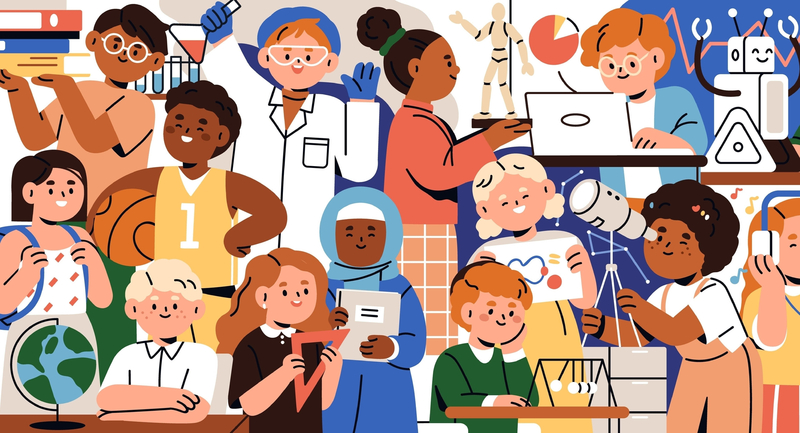In the early 1990s, a coup in Haiti sent a new wave of political refugees to the United States by sea and air. Although thousands of Haitians intercepted at sea were turned back or detained at the U.S. naval base at Guantanamo Bay, some managed to reach the southern Florida shoreline in packed and tattered boats. Others, who had the means to travel by air, landed at local airports.
Both the Miami-Dade County Public Schools and the Broward County Public Schools had been receiving refugee students from Haiti through decades of political instability and violence in that country. In Broward County, the majority of the high school-age refugees were assigned to Dillard High School, a historically black school with deep roots running throughout its Fort Lauderdale neighborhoods, markets, and churches. It seemed that everyone's mother, father, sister, brother, and grandparents had attended Dillard.
In 1994, I was a first-year teacher assigned to teach English and ESOL classes in the school's Annex A5. Within days, the children of Haitian refugees crowded my classroom.
Annex A had a tilted roof that sent rain to puddle in the back of the building. By the look of the stained porcelain toilet in the corner of A5, the building was originally designed for K–3 students. I remember cockroaches, damaged walls, mismatched desks, and an erratic cooling system. Sudden rainstorms (gator gushers) would drench my afternoon students as they ran from the main building to the annex, more than a football field's length away. Helping themselves to fruit from the trees shading the school campus, my students often came to class with oranges, as well notebooks, in hand.
As my students stepped through the door, their attitudes revealed significant class differences. The svelte by-air group dressed in colorful silk prints; they were chatty and jazzy, moving with sway and confidence. The stockier by-sea students dressed in cotton solids; they were still, watchful, and aware. One or two days in, a French-speaking by-air student said to his friends, "Coconut drinkers … they are coconut drinkers, all of them." Although my Creole-speaking students smiled, the boundaries were reinforced.
My college sociology and psychology classes had made me aware of the human tendency to emphasize group differences, elevating one's own group by identifying "the other." But with my students' united journey in search of freedom, I had expected more unity. Nevertheless, I fell in love with them—all of them.
Making a Start
As a new teacher, I focused on adapting to the physical space, getting to know my students, and developing lessons guided by the reading, writing, speaking, and drama objectives for the ESOL English 10 course. Most of my students were natural storytellers, experts in following or telling a winding narrative. I encouraged class conversation, and the students talked about their experiences in their new school, cobbling together a shared understanding of the overall culture of the school from their stories of the hallways, classrooms, and cafeteria. As their talk moved comfortably about the room, we gradually got to know one another.
With few materials and nonsensical textbooks, I looked for common ground around which to build a curriculum for students with widely differing degrees of English fluency. In writing workshops, I had students work in groups of four to revise their responses to writing prompts and then share them aloud. For example, one weekend I attended a reading event by Edwidge Danticat, who had emigrated from Haiti to the United States at age 12. That Monday I brought in some quotations from her novel Breath, Eyes, Memory: "It is the calm and silent waters that will drown you"; "There is always a place where, if you listen closely in the night, you will hear a mother telling a story"; and "The things one does, one should do out of love." After we talked about these ideas, I asked students to respond in 150–200 words.
Powerful tutorial friendships emerged from this joint work—friendships that spanned the two cultures in the room. But the most significant common ground we found came out of an unlikely place: Guantanamo.
A Common Concern About Injustice
Today, the politics of detainment at the Guantanamo Bay naval base are most closely associated with the September 11 attacks and the war on terrorism. In the early '90s, however, thousands of Haitian refugees were held in a vast tent city at the naval base. Whether my students had arrived in a plank boat or in a first-class airplane seat, almost all of them had family members or friends locked up at Guantanamo. My students were both worried and angry. Talk of injustice was their common thread, so the word justice became our theme that first semester.
Students' voices were transferred to paper as they wrote passionate letters to family and friends at the Guantanamo base, which we eventually collected and mailed in one large envelope.
Dear My Father,
It is nice to have a father like you. You care so for your children, and you accept doing things for us. That is why I love you so much. … Now I love you even more and more because you sent my brother over to our house. Thanks a lot.
Dear Sister,
How are you? I think you are fine. Let me tell you about myself. I am in the 10th grade at Dillard High School. I'm not doing so well. I have some class I fail. Like mathematics class. I always get an F in it. I'm so happy to write to you this letter. Please write me back. I need your letter.
Dear Esther,
I watch you out my window as the sun shines on the morning just so I can see if you are thinking about me. Every time I see you I feel stronger; because without you, there is no me. You run my heart like the sun runs the day through the night.
To expand students' knowledge of Guantanamo and to demonstrate the skill of argumentation, I brought in dueling news articles. Students also read about Haiti's geography, history, and politics. When they were finished reading an article, they highlighted their favorite words and assembled them into powerful free-verse imagistic poems.
With self-identity and group identity strengthened, I next brought in non-Guantanamo readings related to the justice theme to expand their knowledge—readings from Jamaica Kincaid, Frederick Douglass, Malcom X, Martin Luther King Jr., Angela Davis, Wendell Berry, Elizabeth Cady Stanton, Woody Guthrie, and Mohammed Ali.
We talked, read, wrote, debated, and laughed. Six weeks in, their language skills were becoming fluid and confidence was high. A hardbound edition of the Ultimate Visual Dictionary and the latest Dillard High School yearbook became worn as students identified words, people, and concepts.
"We Are Drummers"
We were hitting all the standards and objectives along the timeline of the county syllabus. But about a third of the way into the school year, another problem came up. It weighed on my students' hearts, troubled their minds, stole their joy, and impeded their learning.
The problem was escalating conflict between the Haitian refugees and the school's African American students. My students felt unwelcome at Dillard. They experienced random attacks, and I listened as they debated whether to fight back. One day a tall, willowy student wrapped in a long Caribbean skirt stood up and said, "We can stop this with one word—Vodou."
She proposed that three girls attach a small doll to the side of their purse or book bag and whisper the word Vodou occasionally as they passed other students in the main building. Even though it played into the misconceptions of the culture and religion of Vodou by intimating pins and curses, the students thought it was a good idea. Within a week, the fighting stopped.
But stopping the fighting was not enough, I told them. They needed to be accepted as their authentic selves by their peers. How could we work this out? Vodou worked to block. What would help to bridge?
Lots of discussion ensued. We should tell our parents. No, they have enough to worry about. We could tell security. But they will blame us. We should fight back. We could talk to a few of them whom we know and see what they say.
Finally one young man raised his voice: "We are drummers, Ms. Brown." No sooner had he spoken than the students began to drum on their wooden desks. Within minutes, it felt like the volume of drumming would blow off the roof. The rhythm, at first a lively beat, soon turned hypnotic. A girl in a flowered skirt jumped to the middle and began to dance and then spin with her arms outstretched like a falcon's wings.
By the end of the period, the students had made plans. They would pack their lunches instead of eating in the school cafeteria, and during lunch period they would carry their desks outside and drum on the grass in front of Annex A5.
In the following days and weeks, many of Dillard's students began to gather around the drumming group during lunch. The power of music, a common passion of youth, worked its magic and created a larger community. Things on the campus settled down; the fighting ended; students began commingling more; and the path back and forth from the main campus to the annex seemed shorter. I will never forget my students' happy eyes and wide smiles as they celebrated themselves, their new friends, and their place in America.
Sharing Their Stories
In March, there was a countywide ESOL academic competition. One of my students took first place in the declamation category. Another student took second in the spelling bee.
As a group, my students won the all-county project trophy for their Mailbox Language project. Their entry grew out of the Guantanamo letters students had written during the school year. In the middle of the second semester, students looked over their writing to reflect on their growth and to choose favorite sentences from their letters. Then they created an oversized, white enamel mailbox stuffed with more than 50 sentence strips, which streamed out of the mailbox's open door like word banners with the text clearly visible. At the competition, our mailbox was positioned on a podium and was surrounded by people reading the strips. The sentences told of family, memories, hopes and fears, struggles in school, work, frustration, and love—all messages sent to Guantanamo from the United States.
In late May, my students brought their winning mailbox and awards back to Dillard and to our principal, John Kelly. He told us to follow him as he walked down the hallway past walls of trophy cabinets filled from top to bottom with bronze athletic awards. Arriving at the front entrance beside the first trophy case, Principal Kelly reached into his pocket for a thick silver ring of keys and thumbed through to a small gold key. He unlocked the glass door, moved aside a shelf of sports trophies, and filled the cleared space with our academic trophies, ribbon, and mailbox.
Building Bridges
Dillard High School's Haitian immigrants faced walls dividing them from others on two fronts—one within their own group, and one within the school at large. Ralph Ellison said, "Education is all a matter of building bridges."1 I witnessed this truth as my students built bridges through a shared passion for justice, the universal language of music, and their willingness to share their personal struggles to inspire others. School provided the setting for this grace to take place, but the students themselves broke down the walls.









